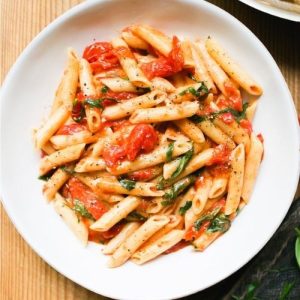
20-Minute Penne Pasta with Cherry Tomatoes
A simple, satisfying penne pasta cooked in a garlicky, buttery cherry tomato sauce, topped with fresh basil and Parmesan. Ready in 20 minutes, this vegetarian dish is perfect for quick dinners or meal prep, offering fiber, plant-based protein, and healthy fats in every bite.
Equipment
- 1 Large Pot – for boiling pasta
- 1 Large Skillet or Sauté Pan
- 1 fine mesh strainer
- 1 Chef’s Knife
- 1 Cutting Board
- Measuring Spoons and Cups
- Wooden Spoon or Spatula
Ingredients
- 1 lb penne pasta
- 2 tbsp olive oil
- 6 tbsp unsalted butter
- 2 garlic cloves thinly sliced
- 3 pints ≈2¼ lbs cherry or grape tomatoes, halved
- ¼ –½ cup grated Parmesan cheese to taste
- 1 large handful fresh basil leaves sliced into ribbons
- Salt to taste
- Black pepper to taste
Instructions
- Prepare the Pasta Water: Fill a large pot with water, adding a generous pinch of salt to enhance the pasta’s flavor. Place the pot over high heat and bring it to a rolling boil. The salted water ensures that the pasta itself is seasoned from the inside, forming a flavorful foundation for the dish.
- Cook the Penne Pasta: Once the water reaches a boil, carefully add the penne pasta. Stir immediately to prevent the noodles from sticking together. Follow the package instructions for cooking time, usually 10–12 minutes for al dente pasta. Stir occasionally throughout the cooking process.Al dente pasta has a firm texture that balances perfectly with the juicy tomato sauce.
- Halve the Cherry Tomatoes: While the pasta cooks, rinse the cherry tomatoes under cold water and gently pat them dry.Using a sharp knife, slice each tomato in half. This allows the natural juices to release quickly when cooked, creating a rich, flavorful sauce. Set the halved tomatoes aside in a medium bowl.
- Heat the Butter and Olive Oil: In a large skillet or sauté pan, add the butter and olive oil. Place the pan over medium heat and allow the butter to melt completely, blending with the olive oil. The combination of butter and olive oil creates a rich, smooth base for the sauce while balancing flavors and adding healthy fats.
- Sauté the Garlic: Add the thinly sliced garlic to the hot butter-oil mixture. Stir constantly for about 30 seconds, just until the garlic becomes fragrant. Be careful not to let it brown, as burnt garlic can impart a bitter taste. This step infuses the oil with garlic aroma, which will evenly flavor the sauce.
- Cook the Tomatoes: Gently add the halved cherry tomatoes to the skillet, spreading them evenly across the pan. Sprinkle a pinch of salt and a few grinds of black pepper over the tomatoes. Stir occasionally and allow them to simmer for 5–7 minutes. During this time, the tomatoes will soften, release their natural juices, and slightly thicken into a luscious sauce.
- Add Parmesan for Creaminess: Once the tomatoes have released their juices, sprinkle in a handful of grated Parmesan cheese. Stir thoroughly to combine, allowing the cheese to melt into the sauce. This adds a savory, slightly creamy texture that complements the natural sweetness of the tomatoes. Taste the sauce and adjust the salt and pepper if needed.
- Transfer the Pasta to the Sauce: When the pasta is cooked al dente, use a fine mesh strainer to scoop it directly from the boiling water into the skillet. It’s okay if a little cooking water clings to the pasta — it helps loosen the sauce and improves the consistency. Gently toss the pasta in the skillet, ensuring every noodle is coated with the tomato and garlic mixture.
- Incorporate Fresh Basil: Add the fresh basil ribbons to the pasta and toss gently. The heat from the sauce will slightly wilt the basil, releasing its sweet, aromatic flavors without overpowering the dish. Fresh basil elevates the taste and adds a burst of vibrant color to the pasta.
- Plate and Garnish: Portion the pasta into individual bowls or onto a large serving platter.Sprinkle extra grated Parmesan cheese and freshly ground black pepper over the top. Drizzle a small amount of olive oil if desired for added richness. This final touch enhances both flavor and presentation, making the dish visually inviting.
- Serve Immediately: Serve the penne pasta hot for the best texture and flavor. Pair it with a crisp salad or garlic bread if desired. The dish is ideal for a quick weeknight meal, offering a comforting, fiber-rich, and protein-friendly dinner that the whole family can enjoy.
Notes
- Use ripe, sweet cherry or grape tomatoes for the best flavor; underripe tomatoes may result in a less juicy sauce.
- Do not overcook the garlic — it should be fragrant, not browned, to avoid bitterness.
- Keep some pasta cooking water aside; adding a splash helps loosen the sauce if it thickens too much.
- Fresh basil is best added at the end to preserve its aroma and vibrant color.
- Parmesan cheese can be adjusted to taste or substituted with a plant-based alternative for a vegan version.
- This recipe is easily doubled for larger gatherings without losing quality or flavor.